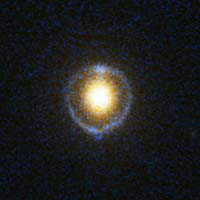
Is
an Einstein ring something you wear on your finger, something you hear
on your cell phone, or neither?
An Einstein ring is probably the most dramatic display of a phenomenon known as gravitational lensing. According to Einstein's general theory of relativity, a massive object (like a star or a galaxy) distorts nearby space. Light passing near such an object is deflected by this gravitational deformation. If something like a galaxy or a quasar is behind one of these massive objects (from our point of view here on Earth), the image of the distant object can be shifted or distorted. Many examples have been seen in which such gravitational lenses produce arc-shaped images of far-away galaxies. A few cases have been seen in which multiple images of an object are generated by the gravitational lens, including an "Einstein cross" with four distinct images of the same quasar.
In the most extreme case, two objects are exactly lined up, and the nearer object also has a nearly-uniform distribution of mass. If both these conditions are fulfilled, the image of the distant object becomes a ring surrounding the image of the nearer object. This ring is called an Einstein ring, because he predicted the possibility in a 1936 paper. Einstein doubted that such rings could be seen, but he did not anticipate the resolution of 21st century telescopes.
Recently, a survey of over 200,000 galaxies seen by the Sloan Digital Sky Survey turned up many candidates for gravitational lensing. A study of some of these with Hubble Space Telescope's Advanced Camera for Surveys discovered eight new Einstein rings. In all these cases, the lenses are giant elliptical galaxies 2,000,000,000 to 4,000,000,000 light years away.
In addition to demonstrating the bending of light in such a remarkable way, these Einstein rings help astronomers learn more about dark matter in the lensing galaxies. As its name implies, dark matter cannot be seen directly, and so its properties can only be deduced indirectly, such as by the amount of distortion it produces in gravitational lensing.

One
of the recently-discovered Einstein rings. Photo Credit: NASA, ESA, and
the SLACS Survey team
Here are some Web sites with information about Einstein rings. Please note that some of these links are not NASA sites, and this listing does not constitute NASA endorsement.
http://www.jb.man.ac.uk/merlin/press/PR9801/picture2.html
- diagram of how an Einstein ring is formed
http://hubblesite.org/newscenter/newsdesk/archive/releases/2005/32/
- photos of the eight new Einstein rings
http://www.universetoday.com/am/publish/
quadruple_ptical_einstein_rings.html?18112005 - description of the
new discoveries
This week's question is provided by Dr. Dave Thompson. Dr. Thompson is an astrophysicist who studies gamma rays in the Exploration of the Universe Division. He helped build, test, and analyze data from EGRET on the Compton Gamma Ray Observatory, and he is now helping build part of the Gamma Ray Large Area Space Telescope (GLAST), scheduled for launch in 2007. His particular scientific interest is gamma-ray pulsars.